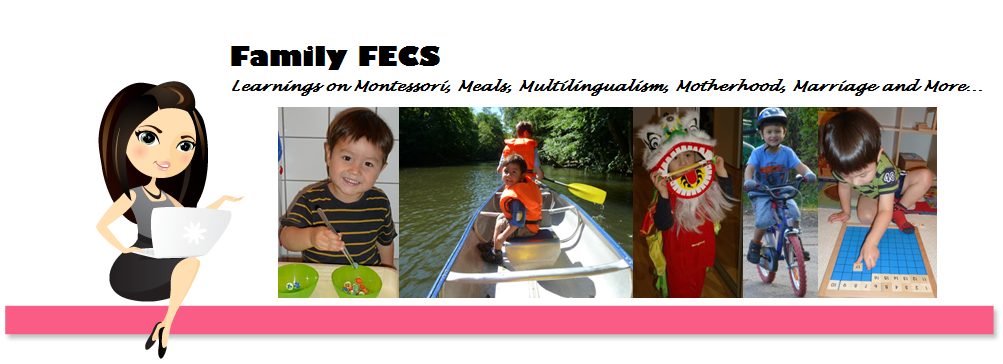I saw some toy shelves for supermarket pretend play at the toy shop last week. I thought it is a very good idea to display the products on a shelf and make the set up look more like a supermarket. But the toy shelf cost a bomb. I found some wooden boxes at home and stack them together like shelves. And I display the supermarket goods as below. Some pictures for memory.
I set up two cashiers, one for Little FECS and one for Baby FECS :-)
This activity can get messy with cleaning up, so brave yourself and choose a day, when you have more surplus and are not in the rush to clean up together with your child. Cleaning up is part of learning for your child too, so it's not time wasted :-)
Below is a re-production of the lesson plan from my previous post reproduced here for convenience:
Objective(s):
1. A fun way to learn:
- number recognition
- counting
- addition
- subtraction
- uses of money
- personal financial management
all into one
Materials:
1. Goods
2. Price tags
3. Toy cash register
4. Money (If you don't have toy money, you can photocopy real money, make it an activity for your child to cut it out, or cut it out for younger children)
5. Shopping basket (optional)
6. Some rough paper and a pen (optional)
Directions:
1. Collect various empty supermarket goods' packaging such as tea, pasta, rice, cheese, eggs, salt, milk, jam, ice-cream box, can food, etc.
2. Arrange them with price tag on a mat. Start with the numbers you want your child to learn. For example, I am revising 1-20 with J, and slowly to 100. Each day, I will concentrate on 20 numbers at a time.
3. Set up the counter with the cash register.
4. Display the price of the items.
5. Start by being the shopper, then take turn to be the cashier and the shopper.
6. As the shopper, point to an item and ask your child how much it costs. He should read the number and tell you the answer.
7. Say the item you wish to buy and give your child that item to scan into his cash register. Reinforce your child's learning by asking him to enter the price into key pad of the cash register. Verify if he has entered correctly. (J loves this the most. At times, when I could not get him to repeat or write the number after me, I would ask him to enter into the cash register the correct number.)
8. Give your child the right amount of money and ask him to verify that it is correct. To increase the level of difficulty later in the game, give your child a bigger note and ask him how much change he should give you back. This teaches the child subtraction and also money management.
9. Put the item that you have bought in your shopping basket.
10. Continue this for a few items and change roles thereafter.
Tips:
1. You can buy two things at the same time and ask your child how much they cost in total? For example choose an item costing $2 and another item costing $4. Ask your child how much in total you should pay him, and let him advise you. Then give him the amount of money he asked.
If he asked for an incorrect amount, revise the addition with him by writing down on paper:
2+4=6
2. Increase the difficulty of this game by increasing the number of items you wish to buy at a single time and invite your child to sum them up.
Additional Information:
J requested for to play Grocery Store or Supermaket Pretend Play often, but it is not my favorite activity, because it is time-consuming and boring for me. I realized that it is because our play has been rather haphazard, messy and a little lacking in purpose. After a few rounds of experience, I have come up with a more fun and clear lesson plan and will quickly jot it down here, before I forget.
Since J loves this so much, to inspire me and excite me to play this game with zest and with my whole heart with him, I think it is worth for me taking the time to make it more structured and more educational. Usually everything I commit to making a lesson plan, I am also more commited to play with J, instead of mommy yawning and falling asleep :-)
This game is very useful in teaching number recognition, counting, addition, subtraction, uses of money and even personal financial management. Oh, why didn't I start working on this earlier, instead of simply making J do more Maths worksheet and Montessori! All because I dreaded to prepare this pretend play! I can't wait to try with J tomorrow!
Gauge as you go along, and be careful not to make it too academic that it loses its fun. I have the tendency to be so.
References:
Here are some links to other ideas with Grocery Play:
http://www.educatall.com/page/442/Grocery-store.html
http://www.preschoolexpress.com/theme_station05/nov05_grocery.shtml
http://www.ehow.com/info_8497233_preschool-activities-supermarkets.html
Without price tags for the younger kids
With price tags for the older kids

